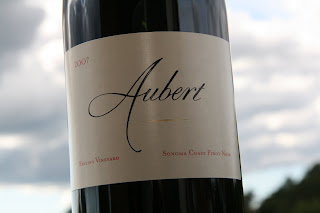
Mark Aubert, former assistant to Helen Turley of Marcassin and wine maker at Peter Michael Winery and Colgin, founded his own company in 1999 to make his own wines – ripe and intensely concentrated wines with a lovely perfume. The chardonnays, which are reminiscent of those from Peter Michael Winery (not surprisingly), were the first wines in the portfolio, but today there’s also a few pinots and a dense, concentrated and well structured Bordeaux blend from Lucia Abreu Vineyard on Howell Mountain.
Until 2007, the wines were made at Colgin winery up on Pritchard Hill, since then Mark Aubert have been renting space at custom crush winery Laird Family Winery in Oak Knoll (where he share space with famous wine makers such as Celia Welch of Corra, Scarecrow and Keever Ranch).
Mark owns 3.20 hectares of vineyard, all in one location – the UV Vineyard in Sonoma Coast. The vineyard is named after the vineyard manager, señor Ulizes Valdez. In addition to that vineyard, grapes are also sourced from other vineyards in Sonoma Coast.
This small company, from which almost the entire production is sold to the members of the mailing list, is a rising star among chardonnay and pinot producers, but the style is riper and more lush than that of for instance Kistler - more towards that of Peter Michael Winery, and Brewer-Clifton.
2007 Pinot Noir Reuling Vineyard / 93 p
Oh yes, this is a California Pinot Noir, ripe and rich for sure, still it is a true beauty! Already at the first sip, it reveals a lively, fresh and explosive flavor with intense notes of raspberries and sweet cherries as well as rose hips, and – which I find very attractive – just a small trace of fresh green grass which adds a very interesting personality to the wine. The first kiss of sweetness is finely balanced with a fresh acidity and a long dry finish, which adds complexity, and tannins are silky. One thing that is quite amazing is that the 15.6 percent of alcohol is so well integrated. There’s just nothing to complain about the alcohol content in this wine, but normally I’m not that forgiving about alcohol levels like this in a pinot. In this case, alcohol is not an issue!
Tasted completely blind, this wine reminded me of the riper, lush and fresh wines from cult producer Brewer-Clifton in Santa Rita Hills, but without the greenish and herbaceous note derived from the stems used by Greg Brewer and Steve Clifton. Apart from that, these wines are very closely related. A good recommendation is to serve this wine at 15-16 degrees Celsius, otherwise the ripe flavors and the higher alcohol might stand out just a bit too much. Looking for burgundian excellence? Then you have to look somewhere else – this is a much more expressive and intense pinot.
Grapes are sourced from the Reuling Vineyard in Sonoma Coast, and it’s said that the clones comes from Richebourg in Vosne-Romanée. The juice is fermented in small open top fermenters with frequent pigeage, and the wine is then matured in all new French oak barrels (the oak flavor is surprisingly well integrated). Production is small, only 110 cases were made.
Drink it 2010-2015.
Until 2007, the wines were made at Colgin winery up on Pritchard Hill, since then Mark Aubert have been renting space at custom crush winery Laird Family Winery in Oak Knoll (where he share space with famous wine makers such as Celia Welch of Corra, Scarecrow and Keever Ranch).
Mark owns 3.20 hectares of vineyard, all in one location – the UV Vineyard in Sonoma Coast. The vineyard is named after the vineyard manager, señor Ulizes Valdez. In addition to that vineyard, grapes are also sourced from other vineyards in Sonoma Coast.
This small company, from which almost the entire production is sold to the members of the mailing list, is a rising star among chardonnay and pinot producers, but the style is riper and more lush than that of for instance Kistler - more towards that of Peter Michael Winery, and Brewer-Clifton.
2007 Pinot Noir Reuling Vineyard / 93 p
Oh yes, this is a California Pinot Noir, ripe and rich for sure, still it is a true beauty! Already at the first sip, it reveals a lively, fresh and explosive flavor with intense notes of raspberries and sweet cherries as well as rose hips, and – which I find very attractive – just a small trace of fresh green grass which adds a very interesting personality to the wine. The first kiss of sweetness is finely balanced with a fresh acidity and a long dry finish, which adds complexity, and tannins are silky. One thing that is quite amazing is that the 15.6 percent of alcohol is so well integrated. There’s just nothing to complain about the alcohol content in this wine, but normally I’m not that forgiving about alcohol levels like this in a pinot. In this case, alcohol is not an issue!
Tasted completely blind, this wine reminded me of the riper, lush and fresh wines from cult producer Brewer-Clifton in Santa Rita Hills, but without the greenish and herbaceous note derived from the stems used by Greg Brewer and Steve Clifton. Apart from that, these wines are very closely related. A good recommendation is to serve this wine at 15-16 degrees Celsius, otherwise the ripe flavors and the higher alcohol might stand out just a bit too much. Looking for burgundian excellence? Then you have to look somewhere else – this is a much more expressive and intense pinot.
Grapes are sourced from the Reuling Vineyard in Sonoma Coast, and it’s said that the clones comes from Richebourg in Vosne-Romanée. The juice is fermented in small open top fermenters with frequent pigeage, and the wine is then matured in all new French oak barrels (the oak flavor is surprisingly well integrated). Production is small, only 110 cases were made.
Drink it 2010-2015.








